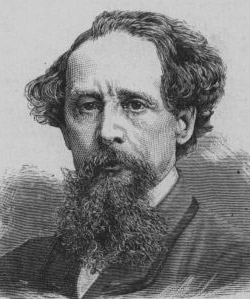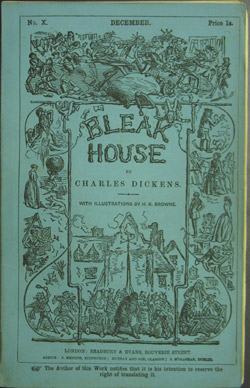
So, I’m sure that the first thought today’s readers have about Charles Dickens would not be as a crime writer. Yet there he was, during a time when writing about crime was a fledgling pursuit, putting the mysterious side of life squarely in his stories. A quick review of novels written by Dickens gives us an obvious link to his status as a leader in the development of fiction about crime and criminals. In one of Dickens’ earliest works, Oliver Twist, which was serialized in Bentley’s Miscellany from 1837 to 1839, we meet the master criminal Fagin who seduces young homeless boys and turns them into criminals. Oliver Twist is the source of this famous bit of dialogue that suits crime readers much more than anything Tiny Tim had to say: “If the law supposes that,” said Mr. Bumble, “the law is a ass, a idiot.”

And then there are the short stories and vignettes that Dickens wrote throughout his career. For several years, Dickens worked on a project called Master Humphrey’s Clock. This weekly series of stories and essays were written as if they were told by Master Humphrey’s friends while sitting around his grandfather clock. Topics spanned from humor to horror. One of the most famous Master Humphrey stories, “Confession Found in a Prison in the Time of Charles the Second,” is widely considered to be a supernatural or horror story. But I think it is primarily a tale about a heinous crime which is remarkably similar in plot and tone to Edgar Allan Poe’s “The Tell Tale Heart,” published a few years later.
In Household Words, a weekly magazine that Charles Dickens wrote and edited from 1850 to 1859, he often continued to explore his fascination with professional detectives in such short pieces as “The Detective Police” and “On Duty with Inspector Field.” Wilkie Collins was also an editor of Household Words and co-authored a number of stories with Dickens. Collins is widely credited as being a founding father of detective fiction even though his seminal novel, The Moonstone, was actually published much later than most of the Dickens’ novels that included crime, detectives, or both.
So, while we consider Dickens to be a writer who wrote many classics of English literature during his prolific lifetime, it’s important that we don’t forget his steadfast contributions to crime and detective fiction during the very early days of the genre.
According to Terrie, writing short mystery fiction is nearly as much fun as hanging out with any or all of her seven grandchildren. One of her recent shorts can be found in the anthology Crimes By Moonlight, and another can be read on the Beat To A Pulp website. Terrie blogs with the Women of Mystery.

Terrie – Loved this post. I had no idea that Wilkie Collins wrote a few stories with Dickens. Have you read any of those stories? I might have to get ahold of them. I read the WOMAN IN WHITE and THE MOONSTONE many years ago and loved both.
Deb, I enjoyed The Moonstone and absolutely loved Woman in White. I haven’t read any of the Dickens/Collins collaborative works but you can find a [url=http://en.wikipedia.org/wiki/Charles_Dickens_bibliography]fairly complete list here[/url].
Thanks for the list. I had no idea there were nine stories they co-wrote, a couple with others as well. Do you know the story behind those? Why there were as many as 4 co-authors on several of the stories?
Hi Deb, these “short stories” were on the long side. Here is [b][url=http://en.wikipedia.org/wiki/A_House_to_Let]an explanation[/url][/b] for the four way partnership that wrote “A House To Let.” “The Haunted House” was published in a weekly periodical. Dickens framed the contents and wrote the first and last installment and the five middle chapters were each written by a different author, including Wilkie. I guess this type of putting a story together came naturally to Dickens since he also functioned as a publisher and an editor at various times.
As a Writer for Wikipedia, Charles was one of my ideals since my childhood, Actually, my father was also a writer and they always told me to follow one ideal person in life and enjoy the rest of life with happiness
i am a big lover of Charles Dickens books and his personality, recently i am read Introduction of Charles family on Wikipedia and i know about writers thinking , because i am also a writer and professional Wikipedia Writer IN American